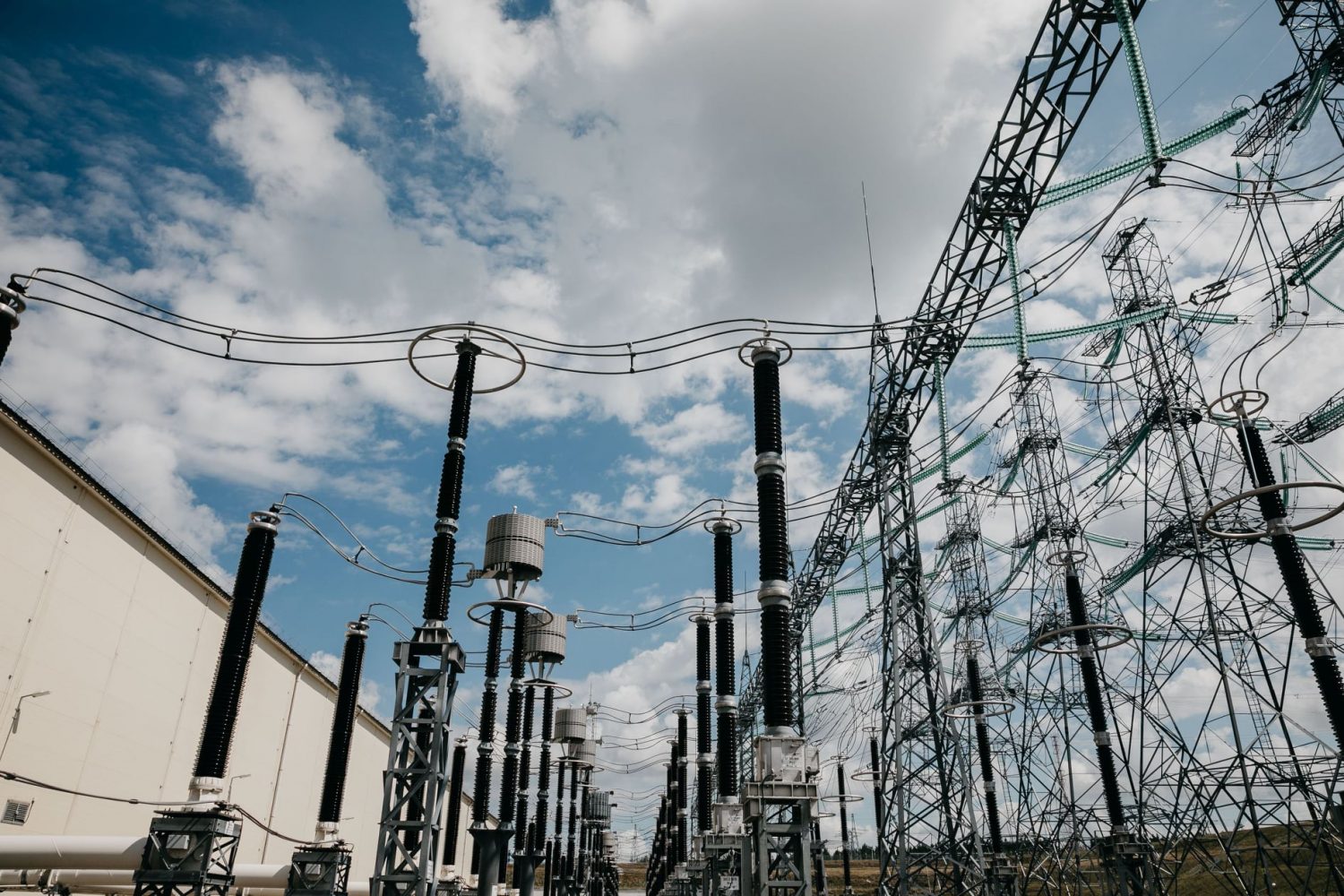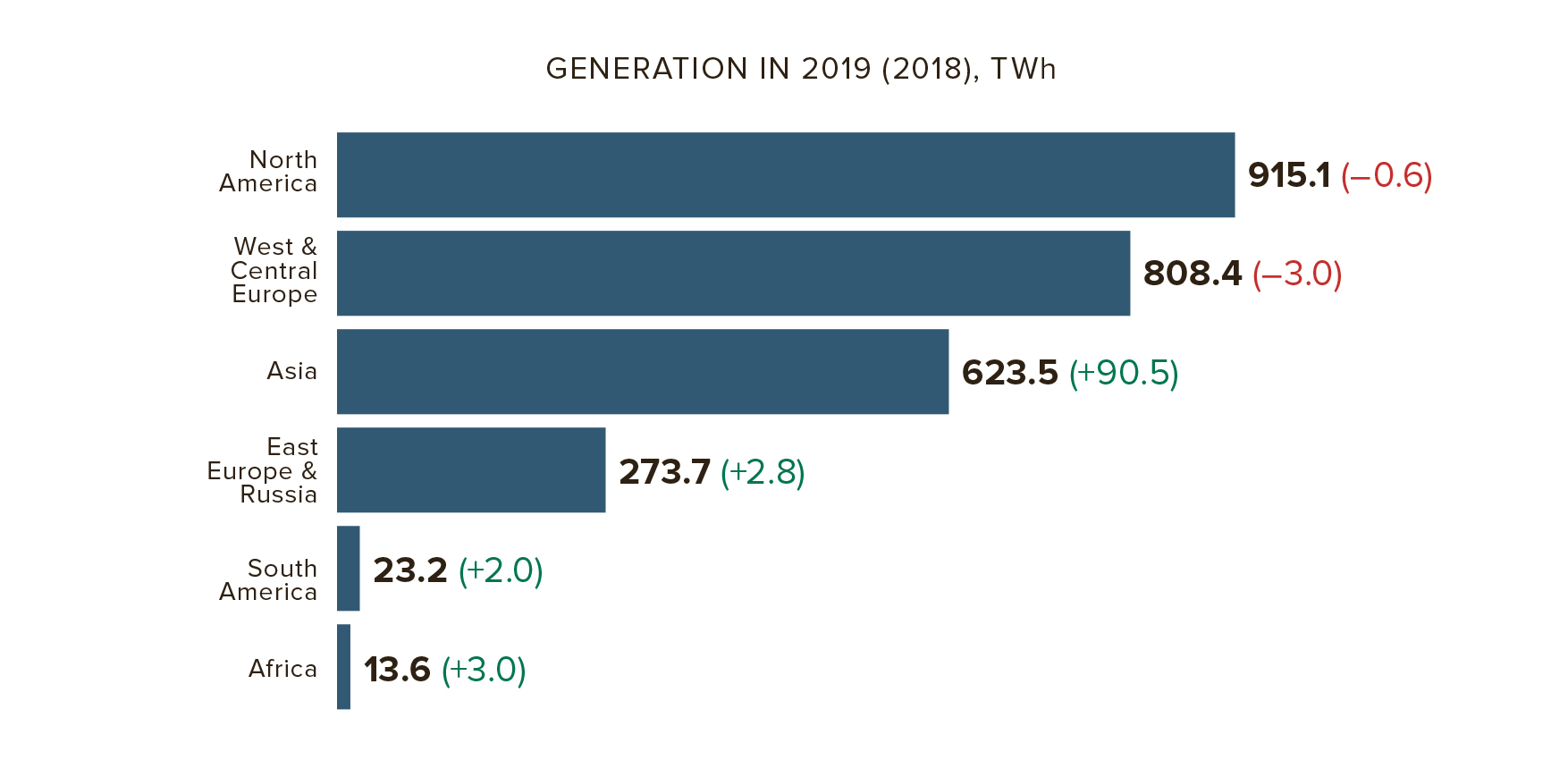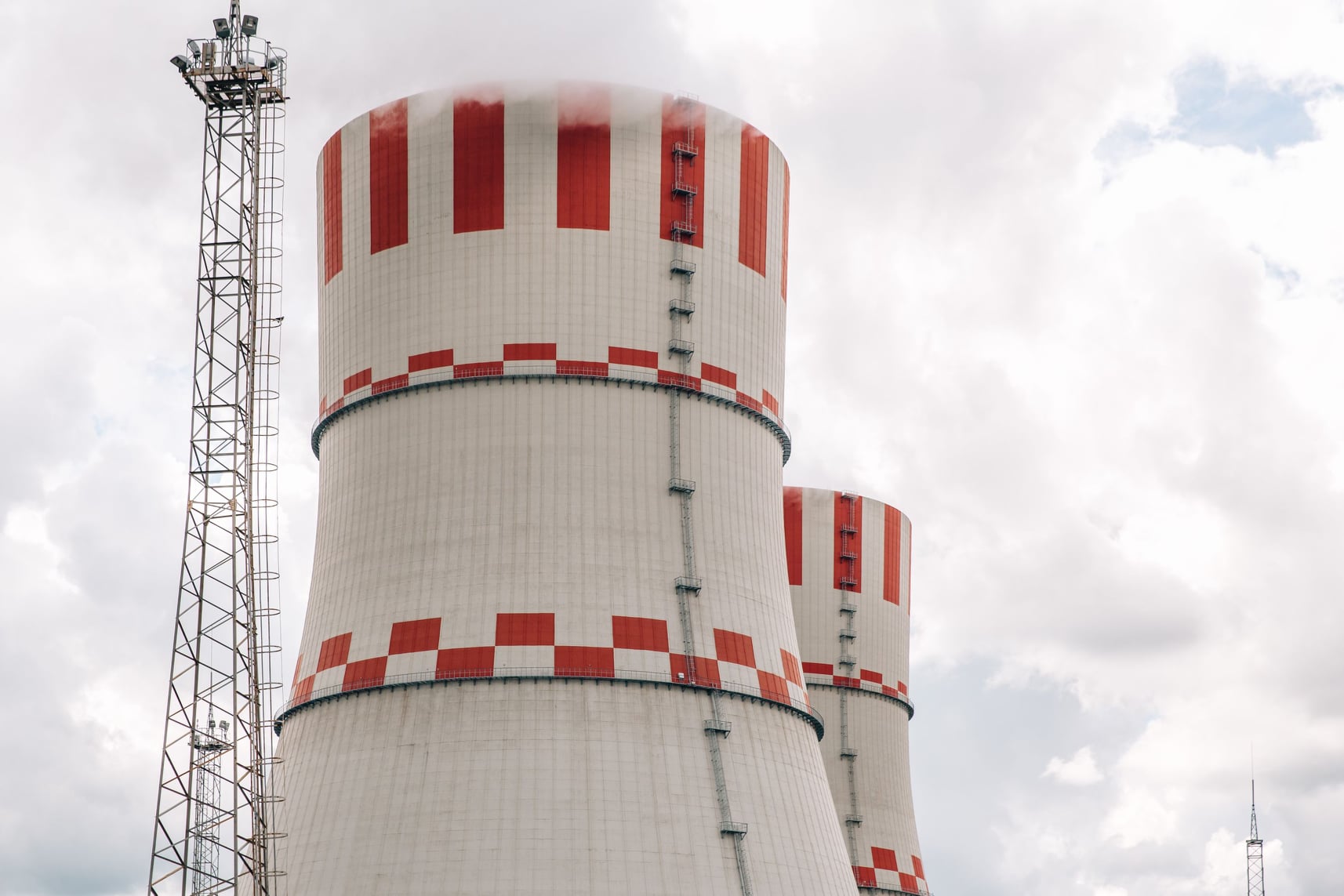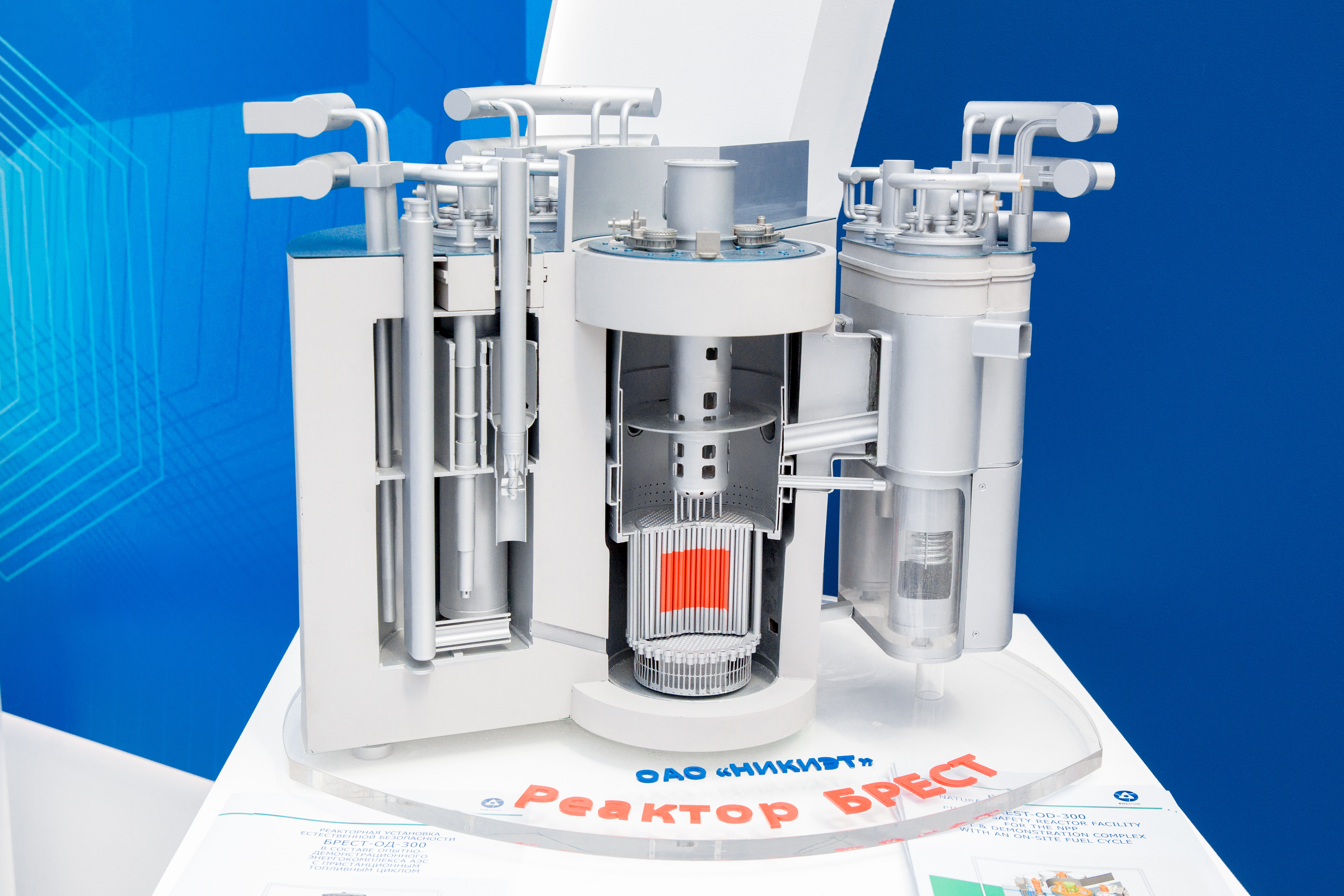
Nuclear Flexibility
back to contentsElectricity generation
In 2019, nuclear power plants generated 2,657 TWh of electricity — an increase of 95 TWh compared to 2018 and 331 TWh compared to 2012. This record high output is second to only 2006 when nuclear reactors produced 2,661 TWh of electric power, a historic high in nuclear generation.
Changes in nuclear generation were irregular across continents, and so was their significance. In Western and Central Europe and North America, nuclear generation decreased marginally, by less than one percent. In Russia and Eastern Europe, nuclear generation demonstrated growth — not decline — but it was marginal as well, at little more than one percent. In South America, electric power production by nuclear power plants went up by almost 10 % year-on-year, and Asia demonstrated a nearly 15 % increase. In relative numbers, the highest increase in power generation was seen in Africa (up 22 % year over year), which is clearly driven by a low-base effect.
“Given the reduction in overall nuclear capacity, the increase in generation in 2019 is all the more remarkable,” WNA Director General Agneta Rising writes in the preface to the report.
Reactor fleet
Six reactors were brought online in 2019 (three less than in the previous year). The leader in new connections was Russia with its three reactors, two KLT‑40S on board Akademik Lomonosov FNPP and one VVER‑1200 at Novovoronezh NPP. Also in 2019, Yangjiang 6 and Taishan 2 were connected to the grid in China, and Shin Kori 4 in South Korea. The KLT‑40S reactors on board Akademik Lomonosov are, in fact, the first small modular reactors put into operation in the 21st century.
Thirteen reactors were decommissioned in 2019. “This is the joint second highest number of reactors shut down in a single year. However, for the majority of these reactors, 2019 was only the formal shutdown date, having ceased generation between 2011 and 2017,” the report reads. The majority here refers to four reactors in Japan. Three more reactors, one in each of South Korea, Germany and Taiwan, were shut down prematurely in accordance with national phase-out policies of these countries.

Five reactors started construction in 2019, two in China and one in each of Iran, Russia and the UK. “Hinkley Point C2 began construction one year after Unit 1. This plant is the first new nuclear construction in the UK for 30 years,” the report says. In Russia, construction started at Kursk II Unit 2, which will have a Generation III+ VVER-TOI reactor, according to Rosenergoatom. VVER-TOI is an acronym of the Russian phrase ‘Water-Cooled Water-Moderated Energy Reactor Universal Optimized Digital’. The VVER-TOI design uses digital solutions and relies on expertise from Leningrad II and Novovoronezh II. It is also characterized by improved earthquake resistance, possibility of load following, crash-proof reactor buildings (capable of withstanding a 400-ton airplane crash), and the possibility of using MOX fuel. The VVER-TOI reactor at unit 2 of Kursk II NPP is expected to serve as a model for other reactors to be built in Russia and abroad.

A total of 55 reactors were under construction as at the end of 2019, one less than in the previous year.
Capacity utilization
The global average capacity factor grew by 27 % to 82.5 %. According to the WNA, Asia was a leader in capacity utilization growth over the last five years. As shown in the diagram, the capacity factor increased 8 % to 10 % to reach 80 % in 2019. WNA experts point out that there has been a historically upward trend in capacity utilization. “There was a substantial improvement in capacity factors achieved from the 1970s through to the 2000s. Since then, this high performance has been maintained. In the 1970s less than half of all reactors achieved a capacity factor greater than 70 %, compared to 83 % of reactors in 2019.” Also in 2019, the number of reactors with a capacity factor greater than 95 % increased greatly, the report shows.
With power consumption decreasing in some countries on the back of production decline caused by the coronavirus pandemic in 2020, nuclear reactors often operated in the load following mode. “With load-following increasing in some countries, a greater spread of capacity factors may be seen in the future,” the authors of the report assume.
Forced flexibility
Flexible operation of nuclear power plants is discussed in an interview with Stephane Feutry, Head of Nuclear Power Performance at EDF, in the Cases section of the report. Answering the question of whether the ability to operate flexibly is unique to reactors of the type operating in France, Stephane Feutry said that every reactor was flexible to a certain degree. In France, most of its nuclear reactors can reduce their power twice every day, going down to 20 % of nominal power in half an hour. This capability is not used that often — only about 15 times a year — but this figure is growing because more and more renewable electricity is being injected into the grid.
A source in Atomstroyexport (Rosatom’s engineering division) has confirmed to Rosatom Newsletter that reactors built by Rosatom abroad also have the load following capability. “VVER‑1200 reactors were initially conceived to be capable of daily power variations. They can go down from 100 % to 50 % of their power capacity and return to 100 % again,” Andrei Kuchumov, First Deputy CEO for Technology Policy at Atomenergoproekt, says. The VVER design allows power output to be decreased at 1 % of the reactor’s nominal capacity per minute and increased at 3 % per minute. In case of accidents in the electricity grid, the reactor can be ramped up at 5 % of its nominal capacity per minute and ramped down at 20 % per minute. The load-following mode is provided for by the designs of all nuclear power plants, which are now in the process of construction, including Kursk II, Akkuyu, Hanhikivi and Paks II.
In the interview to WNA, Stephane Feutry said with confidence that flexible operation is safe and has no impact on reactor equipment and therefore no consequences for the environment. “Control room operators are trained to monitor and operate their plant in flexible mode. There is not a lot of additional maintenance,” he explains.
Andrei Kuchumov confirms that flexible operation of nuclear reactors is safe. “When developing the VVER design, much attention was paid to safe and reliable operation in the load-following mode throughout the reactor life. Tests conducted at Novovoronezh II showed that the reactor performance remained within the operating limits while the power output changed from 100 % to 50 % and back to 100 % of the reactor’s nominal capacity.”

Andrei Kuchumov noted that nuclear fuel is most effectively used in the base load mode. It is preferred for power grids that include power-generating stations of other, more flexible types with an easily adjustable power output. “Load following allows generating as much electricity as needed at a particular time, but affects economics of a nuclear power plant. What is more, the load following mode generates more radioactive waste as a result of adjusting the coolant level and concentration of boric acid in the reactor,” Kuchumov explains.
Stephane Feutry explained in the interview how French nuclear power plants remain efficient in economic terms even when they operate flexibly. Reactors turn to be most efficient in evening peak hours when both demand and prices are higher and solar generation does not contribute to the energy mix. When power prices in the market are low or much electricity from solar farms is fed into the power grid, nuclear power plants generate less electricity. “EDF reactors also provide frequency regulation. The fuel unused during this variation is still available. This allows EDF to choose the best period for the next refueling outage. As consumption and prices are higher in winter, it is then possible to schedule an outage in April instead of in February for instance,” Stephane Feutry explained the benefits. He expressed a hope that nuclear generating stations would remain economically efficient even when renewable sources produced more electricity. However, dissatisfaction with the growing share of renewables in the energy mix can still be felt in his words, “We do not need to reduce the output of individual reactors any lower than 20 % or ramp down output any faster. However, we will need to make those variations simultaneously on more and more plants, which will require more accurate scheduling of maintenance or tests performed in baseload.”
Flexibility in nuclear generation, including in the time of the pandemic, was also touched upon in the interview given to the WNA by Marc Ringeisen, Deputy Director at EDF Centre Opérationnel Production Marchés.
The WNA report also analyzes operational safety of nuclear power plants during the COVID‑19 pandemic by studying the cases of Japan and South Korea. Other interviews deal with the commissioning of the first AP‑1000 reactor in China and Barakah Units 1 and 2 in the UAE.
Other news
The Country Pages section of the report contains news from the countries with operable nuclear reactors. Two events were mentioned in a brief review of Russia. First, the BREST-OD‑300 reactor started construction in December 2019. It is a lead-cooled fast reactor constructed as part of the Proryv (Breakthrough) Project. What makes it different is its inherent safety. Its passive safety systems use the laws of nature and properties of materials to make the pilot reactor safe. Second, the Russian regulator Rospotrebnadzor issued a permit in April 2020 to extend the service life of the sodium-cooled BN‑600 fast neutron reactor until 2025. Rosenergoatom plans to extend the operating permit until 2040.

Shunning anti-nuclear dogmas
Special attention needs to be paid to the concluding remarks of WNA Director General Agneta Rising. She reminds the readers that nuclear can support national economic recovery efforts in the post-COVID period, “Supporting existing nuclear generation and promoting new nuclear build will boost economic growth in the short-term and underpin the development of a low-carbon, resilient and cost-effective electricity infrastructure. Nuclear projects attract valuable inward investment, driving sustained long-term local and national economic growth.” Unlocking the full potential of nuclear generation is impossible without political will. Ms. Rising is confident that countries will not be able to achieve their environment protection goals without nuclear generation, and energy costs will be higher, “We cannot afford to allow a minority of countries promoting their ill-judged anti-nuclear dogma to dictate and restrict multilateral action on energy and the environment. The failure to include nuclear energy in the European Commission’s sustainable finance taxonomy from the very start, thereby potentially hampering the financing of new nuclear projects, runs counter to its “do no significant harm” principle — constraining nuclear energy will mean more pollution and higher carbon emissions, as well as less reliable supply and higher prices for consumers.”
Photo: BREST-OD‑300 reactor model




